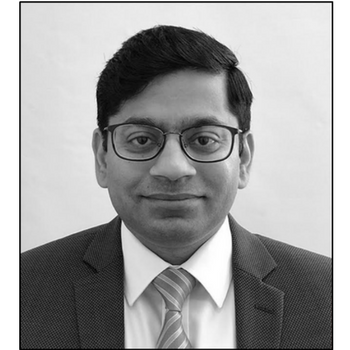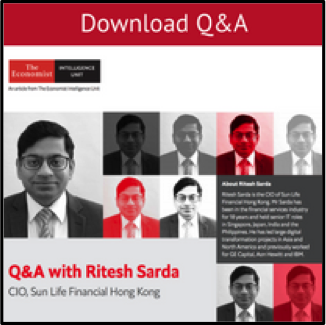In this Q&A, The EIU asks Ritesh Sarda, CIO of Sun Life Financial Hong Kong, about the changing role of the CIO, digital transformation in the financial services industry and how CIOs can leverage emerging technologies to enable their business strategies. Ritesh Sarda is the CIO of Sun Life Financial Hong Kong.
Mr Sarda has been in the financial services industry for 18 years and held senior IT roles in Singapore, Japan, India and the Philippines. He has led large digital transformation projects in Asia and North America and previously worked for GE Capital, Aon Hewitt and IBM.
_______________________________________________________

_______________________________________________________
The role of the CIO has moved beyond simply managing technology to offering a competitive advantage for business. A great CIO is an absolutely unique differentiator. Throughout my career and during my time at Sun Life Financial, I’ve learned there are two aspects of the job that have become crucial to maintaining that differentiation.
First, it’s important for a CIO to be cognizant of all the emerging technologies and solutions in the market—not just the local market but also the global market and in global industries. You have to look beyond your own industry and geography. Given our global reach at Sun Life Financial, we always look to Singapore, China and Canada for innovative business scenarios and usage of advanced technology. For example, we admire WeChat and Alipay-based payment systems that enable clients to use their platform of choice to make payments.
Second, technologies without business acumen or those that fail to solve the relevant business problem are absolutely useless. CIOs have to become more business savvy and have to be integrated and engrained into the business so that we know how we can use technology to resolve business challenges and make things forward-looking from an industry perspective.
Bottom line, the CIO has moved from the back office to the boardroom. There’s no boardroom conversation that happens without the CIO involved.
The insurance business, primarily the life insurance business, for a very long time has been a very manual, operationally based world. When we look at my role as CIO today, which includes legacy work, digital transformation, information management, security and more, to address this challenge, we must consider a few key principles.
Our digital strategy is based on making sure that: first, we become more client-centric and, second, we empower and enable our financial advisers to become more well informed and connected with clients than they’ve ever been. Client-centric thinking is paramount from a digital transformation perspective because most of our relationships are with financial advisers. We don’t necessarily have a well-connected client.
For our end-user clients, we built a mobile application, the my Sun Life client app. Clients can see their entire portfolio in a single view, across multiple relationships they might have with Sun Life. If they want to use the app for electronic servicing, to change basic contact information, update beneficiary information or even file electronic claims, it enables them to do that.
We’re working on a mobile-based point of sale system that enables our advisers to complete the sales process on an iPad. They will be able to do financial need analyses, proposal and sales illustrations, and the whole application process, including the payment and underwriting. This facilitates an almost straight-through processing of applications and near-real-time issuance of policy contract to clients.
Finally, we’re working on the adviser home office mobile app, an adviser-servicing platform that enables advisers to respond to client queries more quickly. And as advisers learn what life-changing moments are happening in clients’ lives, the app enables them to do maybe more upselling.
EIU: How do you evaluate digital transformation projects?
When we started a few years back, evaluation was more about keeping up with market changes. Over the last few years, we have matured, and today the key performance indicators (KPIs) are wide ranging and not necessarily only financial KPIs but also the softer KPIs, including adviser churn ratios, client retention, returning and repeat clients, opportunities to do cross-sells and upsells, our Net Promoter Scores and so on.
We now have the right metrics to determine the value of everything we do for client experience, adviser efficiency and operational efficiency. It’s easy to put fancy, front-end digital assets in front of clients and advisers but they don’t help if we have broken operational processes. So, the metrics are also about operational efficiency in terms of how much straight-through processing are we able to do? How are we making our processes more automated?
EIU: How are you leveraging emerging technologies to make those improvements in operational efficiency?
We’re using robotic process automation to make sure that wherever there are inherent system deficiencies, we are able to work on them without having humans do the dirty jobs, and instead have bots streamline those processes. We are using bots in two areas.
One is where there is a lot of manual process, for example, when an application comes through paper or electronically, to look at underwriting, amount histories and existing client claims records. Most often, the operational user has to enter multiple systems to pull out the information. Now, a bot will mimic human behaviour to enter multiple systems, search for the right information and present it to the user to make the sale more quickly.
A second example is in the contact centre. When a client calls up, normally customer services people have to go into multiple systems to find the right information. Now, all they do is fire a bot, and the bot extracts the right information to answer the customer call.
We’ve also done proof of concepts with chatbots that use natural language processing (NLP) to interpret client conversations and conduct system queries to fetch the relevant information from the backend system. We plan to deploy some in the near future.
All of these projects have a very strong layer of data and analytics that serve as glue between the adviser and client. If a client contacts Sun Life—via an adviser, branch offices or the contact centre—everybody gets the holistic view of client interaction across these digital assets.
Data and analytics are also helping us make sense of client behaviours; to do better client segmentations; to make more appropriate and relevant product design based on client demographics; and to facilitate lead generation and outreach to target client segments based on their stage of life, product requirements and so on.
In a nutshell, adviser-oriented, client-oriented, and empowered by data and analytics is what our digital transformation looks like. It lets us address our business challenges and provide deeper insights and recommendations to our clients to help them meet their financial goals.
To learn more about The EIU’s Pioneering Leadership programme, find a full range of insights, including more Q&As, upcoming articles and an in-depth report, here.















